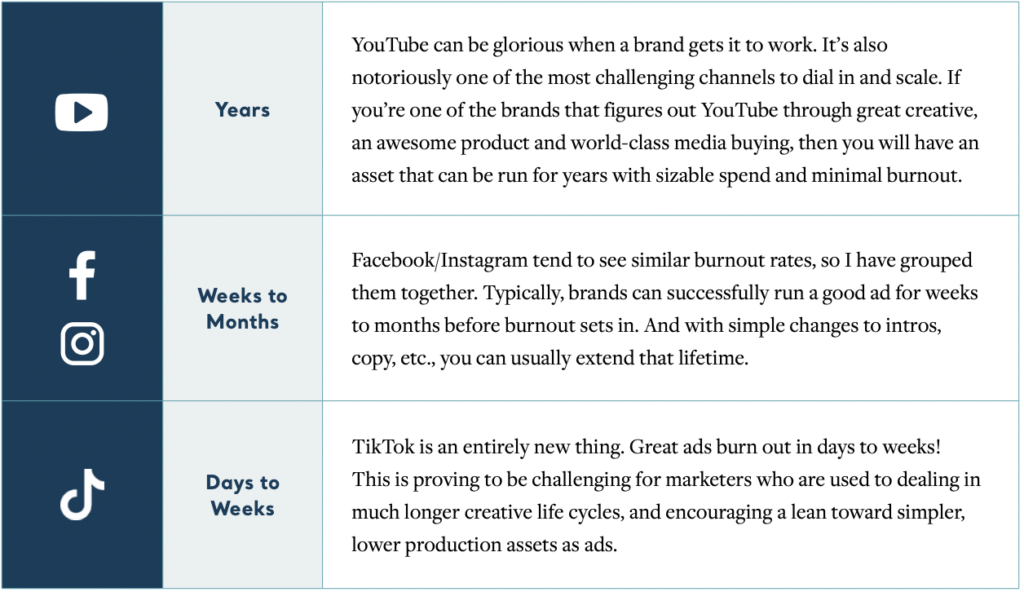This is a featured post from The Q3 Founders’ Report
The Founders’ Report is a quarterly report comprising insights, tips and trends for eCommerce and DtC brands. The information contained comes from interviews with top Founders, Marketers and Entrepreneurs as well as real-time learnings from Raindrop and our clients.
If you’d like to read more content like this subscribe today.
Creative Burnout Rates and How They Impact Your Planning
Does it feel like your ads don’t have the same staying power they used to?
With the increasing growth of TikTok as a strong player in the paid ads arena, we’ve been working with some of the top marketers in the world to make a sustainable, powerful and scalable plan for creative development across all channels in the current climate.
This has become more and more nuanced as the number of potential channels and platforms that you can advertise on continues to grow.
Burnout rate is one of the top factors to consider when you’re looking at budgeting and velocity of assets.
I’m specifically going to look at YouTube, Facebook/Instagram and TikTok in this scenario, but you could arguably add OTT/broadcast, Amazon and lots of other channels to this as well. Maybe one day we’ll go through and do a master chart to reference.
To make sure we’re speaking the same language, when we refer to burnout rate, we’re referencing when an ad that we know worked at one time by hitting the target performance goals sees a drop in performance when consumers (or a specific audience) may have seen the ad too many times.
So, burnout rate is not in reference to ads that have never worked or that we hope will work. 🙂
Typical Burnout Rates by Channel

You may be asking yourself, “Why is there such a huge difference between these three channels?”
Great question.
The answer is the velocity of consumption by users.
The more content that someone consumes on a platform, the faster creative assets will burn out. To be clear, this does not mean the average time spent on a platform or the number of users.
For anyone who has spent time on each of these platforms, you probably know where I’m going with this.
YouTube is primarily a longer format platform and people go on to watch a handful of videos at a time.
Facebook/Instagram users are there to scroll, read, watch, share, etc., which equates to them being served with a higher number of posts in the same amount of viewing time as YouTube.
Then, TikTok took this to a whole new level. Its foundations were in shorter ad formats and the UX is built to keep you scrolling and moving through content.
One day, I’m sure there will be clear data backing all of this up. For now, just imagine when you’re on TikTok vs. YouTube. The pace is totally different, which means users are seeing 10x+ as much content in the same period.
This leads to ads being seen way more often and way faster, which means higher burnout rates.
What does this mean for marketers and brands?
It means we need to figure out how to produce 10x more content without increasing our budgets by anywhere near that.
The reality is that there will need to be budget increases whenever a new channel is introduced, but this also provides opportunities for new and creative ways to generate revenue and meet goals.
As discussed in the previous section, we believe deeply in the power of brand creative, but remain practical in understanding that great UGC and native content work as well.
With this in mind, we’re developing “mashup” services that focus on maximizing the variability and use of higher-production branded assets by combining them with simpler to produce UGC and product-focused content. Our mashup teams can produce a massive number of assets very quickly for testing, variability and to combat burnout rates on channels like TikTok.
If you haven’t read the previous section, I highly recommend doing so to understand our philosophy on branded content and how mashups bring the best of both worlds to brands so they can be nimble and effective in the changing landscape.
You never want to lose sight of your brand.
If you’d like to read more content like this subscribe today to The Founders’ Report.